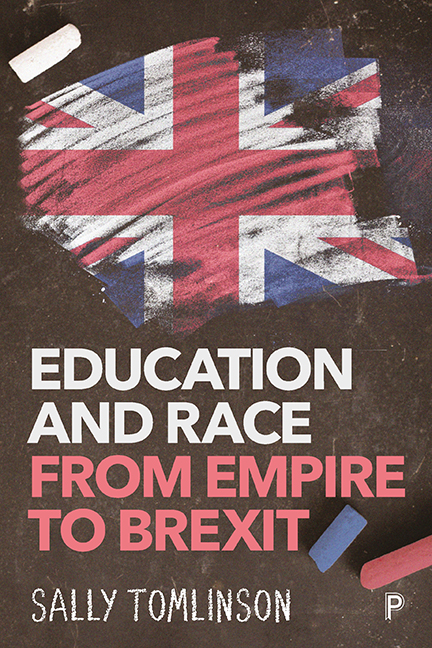Book contents
- Frontmatter
- Contents
- Acknowledgements
- List of abbreviations
- Introduction
- 1 Empire and ethnocentric education
- 2 Internal colonialism and its effects
- 3 Ending empire: Education for ignorance, 1945-1960s
- 4 Post-imperial anxieties and conflicts, 1970-90
- 5 Inequalities, a European Union and education markets, 1990-97
- 6 New Labour: Wars, race and education, 1997-2005
- 7 Not so New Labour: Race and education, 2005-10
- 8 A divided society: Race, class and education, 2010-16
- 9 A dog’s breakfast Brexit, 2016-18
- References
- Index
6 - New Labour: Wars, race and education, 1997-2005
Published online by Cambridge University Press: 27 April 2022
- Frontmatter
- Contents
- Acknowledgements
- List of abbreviations
- Introduction
- 1 Empire and ethnocentric education
- 2 Internal colonialism and its effects
- 3 Ending empire: Education for ignorance, 1945-1960s
- 4 Post-imperial anxieties and conflicts, 1970-90
- 5 Inequalities, a European Union and education markets, 1990-97
- 6 New Labour: Wars, race and education, 1997-2005
- 7 Not so New Labour: Race and education, 2005-10
- 8 A divided society: Race, class and education, 2010-16
- 9 A dog’s breakfast Brexit, 2016-18
- References
- Index
Summary
Miss, why is your skin like this? (Five-year-old white girl to Ghanaian teacher in London in 2005, quoted in Akomaning, 2018)
After 18 years of Conservative rule, the British people were apparently ready for a new Prime Minister and a revamped Labour Party now known as ‘New Labour’. They got this on 1 May 1997, when public school-educated Anthony Charles Lynton Blair became Prime Minister at the age of 43. Much was made of the notion that there was a ‘new dawn’ in politics. His close adviser, Alastair Campbell, wrote in his diaries describing the Blair election win, ‘as we got to the Festival Hall … TB worked the crowd, then up to the lectern and a “new dawn” and they cheered every word’ (Campbell and Stott, 2007: 187). A number of books were hastily written to celebrate this accomplishment, some celebrating and looking forward to his premiership (Mandelson and Liddle, 1996), some more cautious (Rawnsley, 2000), and later some frankly hostile, accusing him of turning the country into Fantasy island (Elliot and Atkinson, 2007). The Campbell diaries and Blair's own memoir (Blair, 2010]) gave their exhaustive account of the years after Blair took over as Leader of the Labour Party, after the untimely death of John Smith in 1994. In his speech to the Labour Party Conference in October 1997 Blair affirmed a commitment to social justice and to education as a means to a socially just society (Blair, 1997a). Then, in 1998, Blair referred to the equal worth of all individuals, claiming that ‘The attack on racial discrimination now commands general support, as does the value of a multicultural society’ (Blair, 1998: 3), and in a later speech celebrated as his 21st-century message, asserted that ‘nations that succeed will be tolerant, respectful of diversity, multiracial, multicultural societies’ (Blair, 1999). So, it may be asked, what went wrong? It might have gone wrong from the start of Blair’s government – although he claimed beliefs in social and racial justice, by the end of his tenure, Blair was blaming black gangs and parents for racial violence, and supporting selective education policies for ‘high flyers’ (Gillborn, 2007).
- Type
- Chapter
- Information
- Education and Race from Empire to Brexit , pp. 141 - 158Publisher: Bristol University PressPrint publication year: 2019



